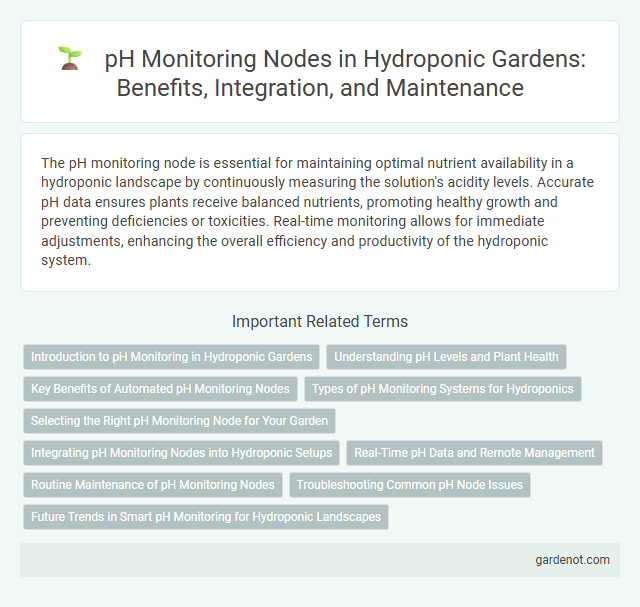The pH monitoring node is essential for maintaining optimal nutrient availability in a hydroponic landscape by continuously measuring the solution's acidity levels. Accurate pH data ensures plants receive balanced nutrients, promoting healthy growth and preventing deficiencies or toxicities. Real-time monitoring allows for immediate adjustments, enhancing the overall efficiency and productivity of the hydroponic system.
Introduction to pH Monitoring in Hydroponic Gardens
pH monitoring nodes in hydroponic gardens are essential for maintaining optimal nutrient availability by accurately measuring the acidity or alkalinity levels of the water solution. Consistent pH levels, typically between 5.5 and 6.5, ensure efficient nutrient absorption and prevent deficiencies or toxicities in plants. Advanced pH sensors provide real-time data, enabling precise adjustments to sustain ideal growing conditions and maximize crop yield.
Understanding pH Levels and Plant Health
Accurate pH monitoring in hydroponic landscapes is critical for optimizing nutrient availability and promoting robust plant growth. Maintaining pH levels between 5.5 and 6.5 ensures efficient nutrient uptake and prevents nutrient lockout, which can impair plant health. Continuous pH monitoring nodes provide real-time data, enabling precise adjustments that enhance overall crop yield and reduce the risk of plant stress or deficiency.
Key Benefits of Automated pH Monitoring Nodes
Automated pH monitoring nodes in hydroponic landscapes ensure precise nutrient solution balance, promoting optimal plant growth and preventing nutrient deficiencies. Real-time data collection reduces manual testing errors and allows for immediate corrective actions, enhancing overall system efficiency. These nodes facilitate consistent crop yields and reduce labor costs by streamlining pH management processes.
Types of pH Monitoring Systems for Hydroponics
pH monitoring systems for hydroponics primarily include analog and digital sensors, with digital systems offering higher accuracy through microprocessor integration. Optical pH sensors utilize fluorescence technology to measure pH levels without direct contact, reducing contamination risks in water-based environments. Wireless pH monitoring nodes enhance real-time data collection and remote management, optimizing nutrient solution stability and plant health in hydroponic landscapes.
Selecting the Right pH Monitoring Node for Your Garden
Selecting the right pH monitoring node for your hydroponic landscape involves prioritizing accuracy, durability, and compatibility with your system's nutrient delivery setup. Look for sensors offering real-time data transmission, easy calibration, and resistance to moisture and chemical corrosion to maintain optimal nutrient balance. Integrating a reliable pH monitoring node ensures healthier plant growth and maximizes yield by preventing nutrient deficiencies and toxicities.
Integrating pH Monitoring Nodes into Hydroponic Setups
Integrating pH monitoring nodes into hydroponic setups ensures real-time regulation of nutrient solutions, optimizing plant growth and preventing nutrient imbalances. These nodes continuously measure pH levels, enabling automated adjustments to maintain ideal acidity between 5.5 and 6.5, crucial for nutrient uptake in hydroponic systems. Advanced pH sensors with wireless connectivity facilitate seamless data collection and remote monitoring, enhancing precision and system efficiency.
Real-Time pH Data and Remote Management
Real-time pH data ensures precise control of nutrient solutions in hydroponic landscapes, preventing nutrient imbalances and promoting optimal plant growth. Remote pH monitoring nodes enable continuous oversight through wireless connectivity, allowing users to adjust pH levels instantly from any location. This integration enhances efficiency, reduces manual labor, and supports healthier, more consistent crop yields in hydroponic systems.
Routine Maintenance of pH Monitoring Nodes
Routine maintenance of pH monitoring nodes in hydroponic landscapes involves regular calibration using standard buffer solutions to ensure accurate pH readings essential for optimal nutrient uptake. Cleaning the sensor with distilled water and mild detergent prevents residue buildup that can skew data and damage the electrode. Replacing the sensor electrode periodically based on manufacturer guidelines maintains system reliability and consistent plant growth conditions.
Troubleshooting Common pH Node Issues
Troubleshooting common pH monitoring node issues involves checking sensor calibration regularly to prevent inaccurate readings caused by drift or fouling. Ensuring the probe is clean and free from deposits is critical for maintaining precise pH measurements in hydroponic systems. Replacing aging electrodes and verifying correct electrical connections also helps resolve signal failures and intermittent data errors.
Future Trends in Smart pH Monitoring for Hydroponic Landscapes
Future trends in smart pH monitoring for hydroponic landscapes emphasize integration with IoT devices and AI-powered analytics to ensure precise nutrient management. Advances in sensor technology enable real-time pH data collection with higher accuracy and durability in varying environmental conditions. Predictive maintenance and adaptive control systems will optimize plant growth by automatically adjusting pH levels based on continuous data insights.
pH monitoring node Infographic

 gardenot.com
gardenot.com